Quantification of Agricultural Terrace Degradation in the Loess Plateau Using UAV-Based Digital Elevation Model and Imagery
Abstract
1. Introduction
2. Materials and Methods
2.1. Study Area
2.2. Data Acquisition
2.3. Evaluation of Terrace Degradation
2.3.1. Extraction of Terrace Ridges
- Step 1.
- The DEMs of the study areas are filled with depressions. The slope values of the DEMs are mapped with grayscale values ranging from 0 to 255. The generated images are smoothed by a Gaussian filter with the size of 5.
- Step 2.
- The gradients in the x and y directions, Gradx(x, y) and Grady(x, y), are calculated by Sobel operations. Then, the image gradient Grad(x, y) and gradient direction θ are calculated.
- Step 3.
- Nonmaximum suppression should be applied based on the gradient direction. If the gradient value of the pixel is less than that of two adjacent pixels in the gradient direction, the value of this pixel is set to 0, indicating that this pixel is not on the edges.
- Step 4.
- The high and low thresholds are calculated adaptively. The calculation formula of the high threshold is as follows:where Gp is the gradient corresponding to the peak value of histogram obtained by the statistics of the gradient in Step 3, Gi is the gradient value of pixel I, N is the total number of pixels, and n is usually 2 or 3. In this study, n equals 3. After the high threshold is calculated, the pixels higher than the high threshold are removed from the gradient graph, and the low threshold is calculated through the same method.
- Step 5.
- The strong and weak edges are connected. The pixels with a gradient greater than the high threshold Th form strong edges. The pixels with a gradient between the high threshold Th and the low threshold Tl form weak edges. The pixels with a gradient lower than Tl form the background. If the weak edge is connected to the strong edge, the weak edge is identified as the edge; otherwise, the weak edge is converted into the background.
2.3.2. Reconstruction of Undamaged Terrace DEM
2.3.3. Calculation of Damage Degree of Terraces
3. Results
3.1. Extraction Results of Terrace Ridges
3.2. DEM Reconstruction Results
3.3. Damage Degree of Terraces
3.3.1. Damage Degree of Terrace Ridges
3.3.2. Damage Degree of Terrace Surfaces
3.3.3. Damage Degree of a Whole Terrace
4. Discussion
4.1. Rationality of the Proposed Method
4.2. Influence of DEM Resolution on Extracting Terrace Ridges
5. Conclusions
Author Contributions
Funding
Data Availability Statement
Acknowledgments
Conflicts of Interest
References
- Capolupo, A.; Kooistra, L.; Boccia, L. A novel approach for detecting agricultural terraced landscapes from historical and contemporaneous photogrammetric aerial photos. Int. J. Appl. Earth Obs. Geoinf. 2018, 73, 800–810. [Google Scholar] [CrossRef]
- Wen, Y.; Kasielke, T.; Li, H.; Zhang, B.; Zepp, H. May agricultural terraces induce gully erosion? A case study from the Black Soil Region of Northeast China. Sci. Total Environ. 2021, 750, 141715. [Google Scholar] [CrossRef] [PubMed]
- Yang, L.; Liu, M.; Lun, F.; Min, Q.; Zhang, C.; Li, H. Livelihood assets and strategies among rural households: Comparative analysis of rice and dryland terrace systems in China. Sustainability 2018, 10, 2525. [Google Scholar] [CrossRef]
- Lasanta, T.; Arnáez, J.; Oserín, M.; Ortigosa, L.M. Marginal lands and erosion in terraced fields in the Mediterranean mountains. Mt. Res. Dev. 2001, 21, 69–76. [Google Scholar] [CrossRef]
- Cammeraat, E.L. Scale dependent thresholds in hydrological and erosion response of a semi-arid catchment in southeast Spain. Agric. Ecosyst. Environ. 2004, 104, 317–332. [Google Scholar] [CrossRef]
- Tarolli, P.; Preti, F.; Romano, N. Terraced landscapes: From an old best practice to a potential hazard for soil degradation due to land abandonment. Anthropocene 2014, 6, 10–25. [Google Scholar] [CrossRef]
- Dorren, L.; Rey, F. A Review of the Effect of Terracing on Erosion; Briefing Papers of the 2nd SCAPE Workshop; Citeseer: Cinque Terre, Italy, 2004; pp. 97–108. [Google Scholar]
- Li, L.; Tonts, M. The impacts of temporary labour migration on farming systems of the Loess Plateau, Gansu Province, China. Popul. Space Place 2014, 20, 316–332. [Google Scholar] [CrossRef]
- Camera, C.; Djuma, H.; Bruggeman, A.A.; Zoumides, C.; Eliades, M.; Charalambous, K.; Abate, D.; Faka, M. Quantifying the effectiveness of mountain terraces on soil erosion protection with sediment traps and dry-stone wall laser scans. Catena 2018, 171, 251–264. [Google Scholar] [CrossRef]
- Socci, P.; Errico, A.; Castelli, G.; Penna, D.; Preti, F. Terracing: From agriculture to multiple ecosystem services. In Oxford Research Encyclopedia of Environmental Science; Oxford University Press: New York, NY, USA, 2019. [Google Scholar]
- Stavi, I.; Gusarov, Y.; Halbac-Cotoara-Zamfir, R. Collapse and failure of ancient agricultural stone terraces: On-site geomorphic processes, pedogenic mechanisms, and soil quality. Geoderma 2019, 344, 144–152. [Google Scholar] [CrossRef]
- Cicinelli, E.; Caneva, G.; Savo, V. A review on management strategies of the terraced agricultural systems and conservation actions to maintain cultural landscapes around the Mediterranean Area. Sustainability 2021, 13, 4475. [Google Scholar] [CrossRef]
- Sáez, E.; Canziani, J. Vernacular architecture and cultural landscapes in the Sondondo valley (Peru). Int. Arch. Photogramm. Remote Sens. Spat. Inf. Sci. 2020, 44, 175–180. [Google Scholar] [CrossRef]
- Ishizawa, M. Landscape change in the terraces of Ollantaytambo, Peru: An emergent mountain landscape between the urban, rural and protected area. Landsc. Res. 2017, 42, 321–333. [Google Scholar] [CrossRef]
- Paliaga, G.; Luino, F.; Turconi, L.; De Graff, J.V.; Faccini, F. Terraced landscapes on portofino promontory (Italy): Identification, geo-hydrological hazard and management. Water 2020, 12, 435. [Google Scholar] [CrossRef]
- Díaz, A.R.; Sanleandro, P.M.; Soriano, A.S.; Serrato, F.B.; Faulkner, H. The causes of piping in a set of abandoned agricultural terraces in southeast Spain. Catena 2007, 69, 282–293. [Google Scholar] [CrossRef]
- Lesschen, J.; Cammeraat, L.; Nieman, T. Erosion and terrace failure due to agricultural land abandonment in a semi-arid environment. Earth Surf. Process. Landf. J. Br. Geomorphol. Res. Group 2008, 33, 1574–1584. [Google Scholar] [CrossRef]
- Kizos, T.; Dalaka, A.; Petanidou, T. Farmers’ attitudes and landscape change: Evidence from the abandonment of terraced cultivations on Lesvos, Greece. Agric. Hum. Values 2010, 27, 199–212. [Google Scholar] [CrossRef]
- Gravagnuolo, A.; Varotto, M. Terraced Landscapes Regeneration in the Perspective of the Circular Economy. Sustainability 2021, 13, 4347. [Google Scholar] [CrossRef]
- Moreno-de-las-Heras, M.; Lindenberger, F.; Latron, J.; Lana-Renault, N.; Llorens, P.; Arnáez, J.; Romero-Díaz, A.; Gallart, F. Hydro-geomorphological consequences of the abandonment of agricultural terraces in the Mediterranean region: Key controlling factors and landscape stability patterns. Geomorphology 2019, 333, 73–91. [Google Scholar] [CrossRef]
- Tarolli, P.; Rizzo, D.; Brancucci, G. Terraced Landscapes: Land Abandonment, Soil Degradation, and Suitable Management. In World Terraced Landscapes: History, Environment, Quality of Life; Springer: Berlin/Heidelberg, Germany, 2019; pp. 195–210. [Google Scholar]
- Sidle, R.C.; Ziegler, A.D.; Negishi, J.N.; Nik, A.R.; Siew, R.; Turkelboom, F. Erosion processes in steep terrain—Truths, myths, and uncertainties related to forest management in Southeast Asia. For. Ecol. Manag. 2006, 224, 199–225. [Google Scholar] [CrossRef]
- Bazzoffi, P.; Gardin, L. Effectiveness of the GAEC standard of cross compliance retain terraces on soil erosion control. Ital. J. Agron. 2011, 6, e6. [Google Scholar] [CrossRef]
- Wickama, J.; Okoba, B.; Sterk, G. Effectiveness of sustainable land management measures in West Usambara highlands, Tanzania. Catena 2014, 118, 91–102. [Google Scholar] [CrossRef]
- Gallart, F.; Llorens, P.; Latron, J. Studying the role of old agricultural terraces on runoff generation in a small Mediterranean mountainous basin. J. Hydrol. 1994, 159, 291–303. [Google Scholar] [CrossRef]
- Brandolini, P.; Cevasco, A.; Capolongo, D.; Pepe, G.; Lovergine, F.; Del Monte, M. Response of terraced slopes to a very intense rainfall event and relationships with land abandonment: A case study from Cinque Terre (Italy). Land Degrad. Dev. 2018, 29, 630–642. [Google Scholar] [CrossRef]
- Sabir, M. The terraces of the anti-atlas: From abandonment to the risk of degradation of a landscape heritage. Water 2021, 13, 510. [Google Scholar] [CrossRef]
- Agnoletti, M.; Errico, A.; Santoro, A.; Dani, A.; Preti, F. Terraced landscapes and hydrogeological risk. Effects of land abandonment in Cinque Terre (Italy) during severe rainfall events. Sustainability 2019, 11, 235. [Google Scholar] [CrossRef]
- Palmer, C.; Colledge, S.; Bevan, A.; Conolly, J. Vegetation recolonisation of abandoned agricultural terraces on Antikythera, Greece. Environ. Archaeol. 2010, 15, 64–80. [Google Scholar] [CrossRef]
- Koulouri, M.; Giourga, C. Land abandonment and slope gradient as key factors of soil erosion in Mediterranean terraced lands. Catena 2007, 69, 274–281. [Google Scholar] [CrossRef]
- Christiansen, M.P.; Laursen, M.S.; Jørgensen, R.N.; Skovsen, S.; Gislum, R. Designing and testing a UAV mapping system for agricultural field surveying. Sensors 2017, 17, 2703. [Google Scholar] [CrossRef]
- Chidi, C.L.; Zhao, W.; Chaudhary, S.; Xiong, D.H.; Wu, Y.H. Sensitivity assessment of spatial resolution difference in DEM for soil erosion estimation based on UAV observations: An experiment on agriculture terraces in the middle hill of Nepal. ISPRS Int. J. Geo-Inf. 2021, 10, 28. [Google Scholar] [CrossRef]
- Schönbrodt-Stitt, S.; Behrens, T.; Schmidt, K.; Shi, X.; Scholten, T. Degradation of cultivated bench terraces in the Three Gorges Area: Field mapping and data mining. Ecol. Indic. 2013, 34, 478–493. [Google Scholar] [CrossRef]
- Cucchiaro, S.; Fallu, D.J.; Zhang, H.; Walsh, K.; Van Oost, K.; Brown, A.G.; Tarolli, P. Multiplatform-SfM and TLS data fusion for monitoring agricultural terraces in complex topographic and landcover conditions. Remote Sens. 2020, 12, 1946. [Google Scholar] [CrossRef]
- Pijl, A.; Quarella, E.; Vogel, T.A.; D’Agostino, V.; Tarolli, P. Remote sensing vs. field-based monitoring of agricultural terrace degradation. Int. Soil Water Conserv. Res. 2021, 9, 1–10. [Google Scholar] [CrossRef]
- Fang, X.; Li, J.; Zhu, Y.; Cao, J.; Na, J.; Jiang, S.; Ding, H. OBIA-Based Extraction of Artificial Terrace Damages in the Loess Plateau of China from UAV Photogrammetry. ISPRS Int. J. Geo-Inf. 2021, 10, 805. [Google Scholar] [CrossRef]
- Fu, B. Soil erosion and its control in the Loess Plateau of China. Soil Use Manag. 1989, 5, 76–82. [Google Scholar] [CrossRef]
- Fu, B.; Wang, S.; Liu, Y.; Liu, J.; Liang, W.; Miao, C. Hydrogeomorphic ecosystem responses to natural and anthropogenic changes in the Loess Plateau of China. Annu. Rev. Earth Planet. Sci. 2017, 45, 223–243. [Google Scholar] [CrossRef]
- An, P.; Inoue, T.; Zheng, M.; Eneji, A.E.; Inanaga, S. Agriculture on the loess plateau. In Restoration and Development of the Degraded Loess Plateau, China; Springer: Berlin/Heidelberg, Germany, 2014; pp. 61–74. [Google Scholar]
- Cao, S.; Xu, C.; Chen, L.; Wang, X. Attitudes of farmers in China’s northern Shaanxi Province towards the land-use changes required under the Grain for Green Project, and implications for the project’s success. Land Use Policy 2009, 26, 1182–1194. [Google Scholar] [CrossRef]
- Delang, C.O.; Yuan, Z. China’s Grain for Green Program; Springer: Berlin/Heidelberg, Germany, 2016. [Google Scholar]
- Feng, Z.; Yang, Y.; Zhang, Y.; Zhang, P.; Li, Y. Grain-for-green policy and its impacts on grain supply in West China. Land Use Policy 2005, 22, 301–312. [Google Scholar] [CrossRef]
- Wei, J.-Z.; Zheng, K.; Zhang, F.; Fang, C.; Zhou, Y.-Y.; Li, X.-C.; Li, F.-M.; Ye, J.-S. Migration of rural residents to urban areas drives grassland vegetation increase in China’s Loess Plateau. Sustainability 2019, 11, 6764. [Google Scholar] [CrossRef]
- Zhao, H.; Fang, X.; Ding, H.; Strobl, J.; Xiong, L.; Na, J.; Tang, G. Extraction of terraces on the Loess Plateau from high-resolution DEMs and imagery utilizing object-based image analysis. ISPRS Int. J. Geo-Inf. 2017, 6, 157. [Google Scholar] [CrossRef]
- Dai, W.; Na, J.; Huang, N.; Hu, G.; Yang, X.; Tang, G.; Xiong, L.; Li, F. Integrated edge detection and terrain analysis for agricultural terrace delineation from remote sensing images. Int. J. Geogr. Inf. Sci. 2020, 34, 484–503. [Google Scholar] [CrossRef]
- Luo, L.; Li, F.; Dai, Z.; Yang, X.; Liu, W.; Fang, X. Terrace extraction based on remote sensing images and digital elevation model in the loess plateau, China. Earth Sci. Inform. 2020, 13, 433–446. [Google Scholar] [CrossRef]
- Ding, H.; Na, J.; Jiang, S.; Zhu, J.; Liu, K.; Fu, Y.; Li, F. Evaluation of three different machine learning methods for object-based artificial terrace mapping—A case study of the loess plateau, China. Remote Sens. 2021, 13, 1021. [Google Scholar] [CrossRef]
- Na, J.; Ding, H.; Zhao, W.; Liu, K.; Tang, G.; Pfeifer, N. Object-based large-scale terrain classification combined with segmentation optimization and terrain features: A case study in China. Trans. GIS 2021, 25, 2939–2962. [Google Scholar] [CrossRef]
- Zhao, F.; Xiong, L.Y.; Wang, C.; Wang, H.R.; Wei, H.; Tang, G.A. Terraces mapping by using deep learning approach from remote sensing images and digital elevation models. Trans. GIS 2021, 25, 2438–2454. [Google Scholar] [CrossRef]
- Lü, H.; Zhu, Y.; Skaggs, T.H.; Yu, Z. Comparison of measured and simulated water storage in dryland terraces of the Loess Plateau, China. Agric. Water Manag. 2009, 96, 299–306. [Google Scholar] [CrossRef]
- Liu, X.; He, B.; Li, Z.; Zhang, J.; Wang, L.; Wang, Z. Influence of land terracing on agricultural and ecological environment in the loess plateau regions of China. Environ. Earth Sci. 2011, 62, 797–807. [Google Scholar] [CrossRef]
- Xu, G.; Zhang, T.; Li, Z.; Li, P.; Cheng, Y.; Cheng, S. Temporal and spatial characteristics of soil water content in diverse soil layers on land terraces of the Loess Plateau, China. Catena 2017, 158, 20–29. [Google Scholar] [CrossRef]
- Bai, J.; Yang, S.; Zhang, Y.; Liu, X.; Guan, Y. Assessing the impact of terraces and vegetation on runoff and sediment routing using the time-area method in the Chinese Loess Plateau. Water 2019, 11, 803. [Google Scholar] [CrossRef]
- Ran, Q.; Chen, X.; Hong, Y.; Ye, S.; Gao, J. Impacts of terracing on hydrological processes: A case study from the Loess Plateau of China. J. Hydrol. 2020, 588, 125045. [Google Scholar] [CrossRef]
- Xu, Q.; Li, W.-L.; Ju, Y.-Z.; Dong, X.-J.; Peng, D.-L. Multitemporal UAV-based photogrammetry for landslide detection and monitoring in a large area: A case study in the Heifangtai terrace in the Loess Plateau of China. J. Mt. Sci. 2020, 17, 1826–1839. [Google Scholar] [CrossRef]
- Xu, Y.; Zhu, G.; Wan, Q.; Yong, L.; Ma, H.; Sun, Z.; Zhang, Z.; Qiu, D. Effect of terrace construction on soil moisture in rain-fed farming area of Loess Plateau. J. Hydrol. Reg. Stud. 2021, 37, 100889. [Google Scholar] [CrossRef]
- Huang, C.; Yang, Q.; Cao, X.; Li, Y. Assessment of the soil erosion response to land use and slope in the loess plateau—A case study of jiuyuangou. Water 2020, 12, 529. [Google Scholar] [CrossRef]
- Pijl, A.; Bailly, J.-S.; Feurer, D.; El Maaoui, M.A.; Boussema, M.R.; Tarolli, P. TERRA: Terrain extraction from elevation rasters through repetitive anisotropic filtering. Int. J. Appl. Earth Obs. Geoinf. 2020, 84, 101977. [Google Scholar] [CrossRef]
- Dai, W.; Hu, G.; Huang, N.; Zhang, P.; Yang, X.; Tang, G. A contour-directional detection for deriving terrace ridge from open source images and digital elevation models. IEEE Access 2019, 7, 129215–129224. [Google Scholar] [CrossRef]
- Ziou, D.; Tabbone, S. Edge detection techniques-an overview. Pattern Recognit. Image Anal. C/C Raspoznavaniye Obraz. I Anal. Izobr. 1998, 8, 537–559. [Google Scholar]
- Maini, R.; Aggarwal, H. Study and comparison of various image edge detection techniques. Int. J. Image Process. 2009, 3, 1–11. [Google Scholar]
- Canny, J. A computational approach to edge detection. In IEEE Transactions on Pattern Analysis and Machine Intelligence; IEEE: Los Alamitos, CA, USA, 1986; pp. 679–698. [Google Scholar]
- Khanal, N.R.; Watanabe, T. Abandonment of agricultural land and its consequences: A case study in the Sikles area, Gandaki Basin, Nepal Himalaya. Mt. Res. Dev. 2006, 26, 32. [Google Scholar] [CrossRef]
- Martínez-Casasnovas, J.A.; Ramos, M.C.; Cots-Folch, R. Influence of the EU CAP on terrain morphology and vineyard cultivation in the Priorat region of NE Spain. Land Use Policy 2010, 27, 11–21. [Google Scholar] [CrossRef]
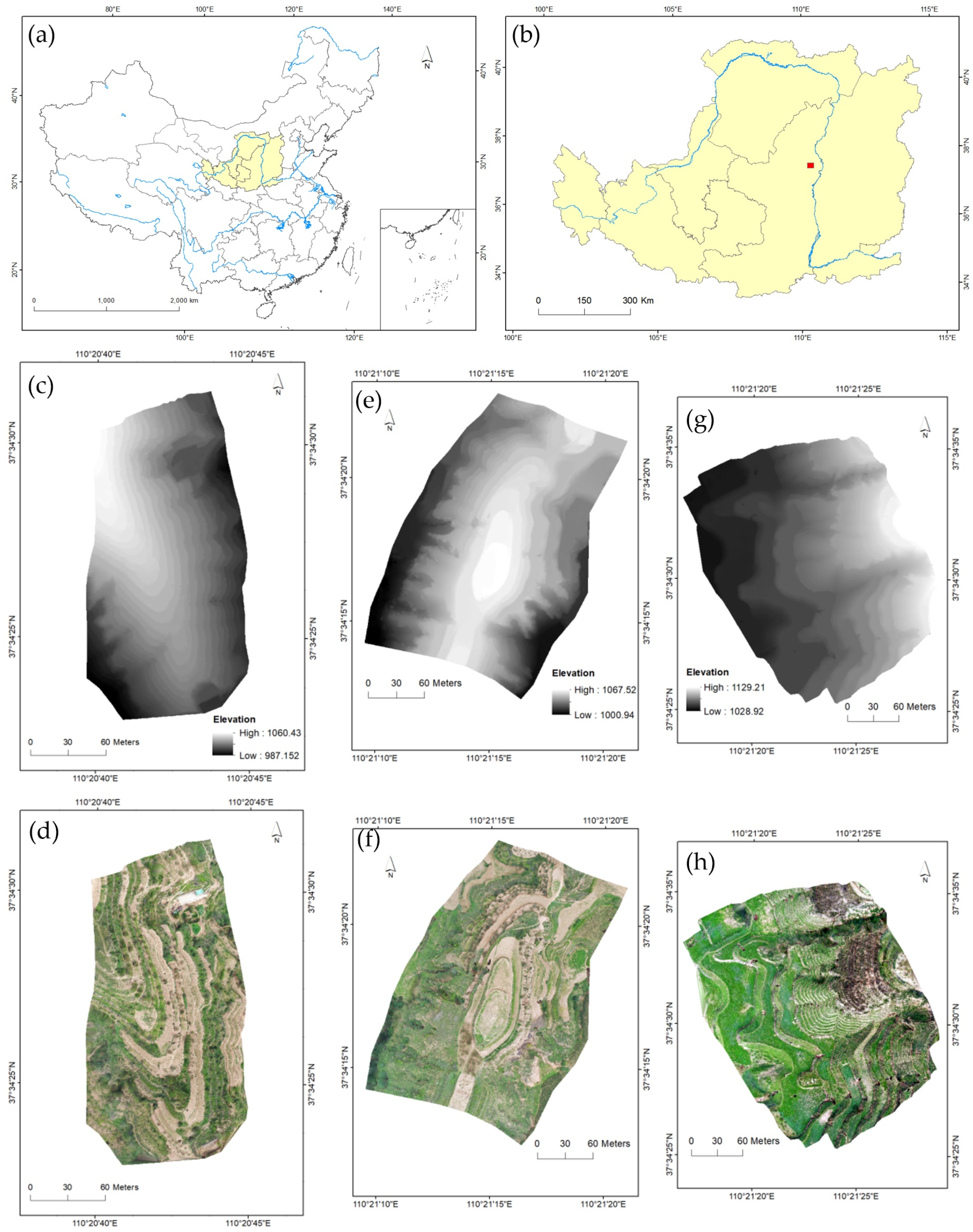
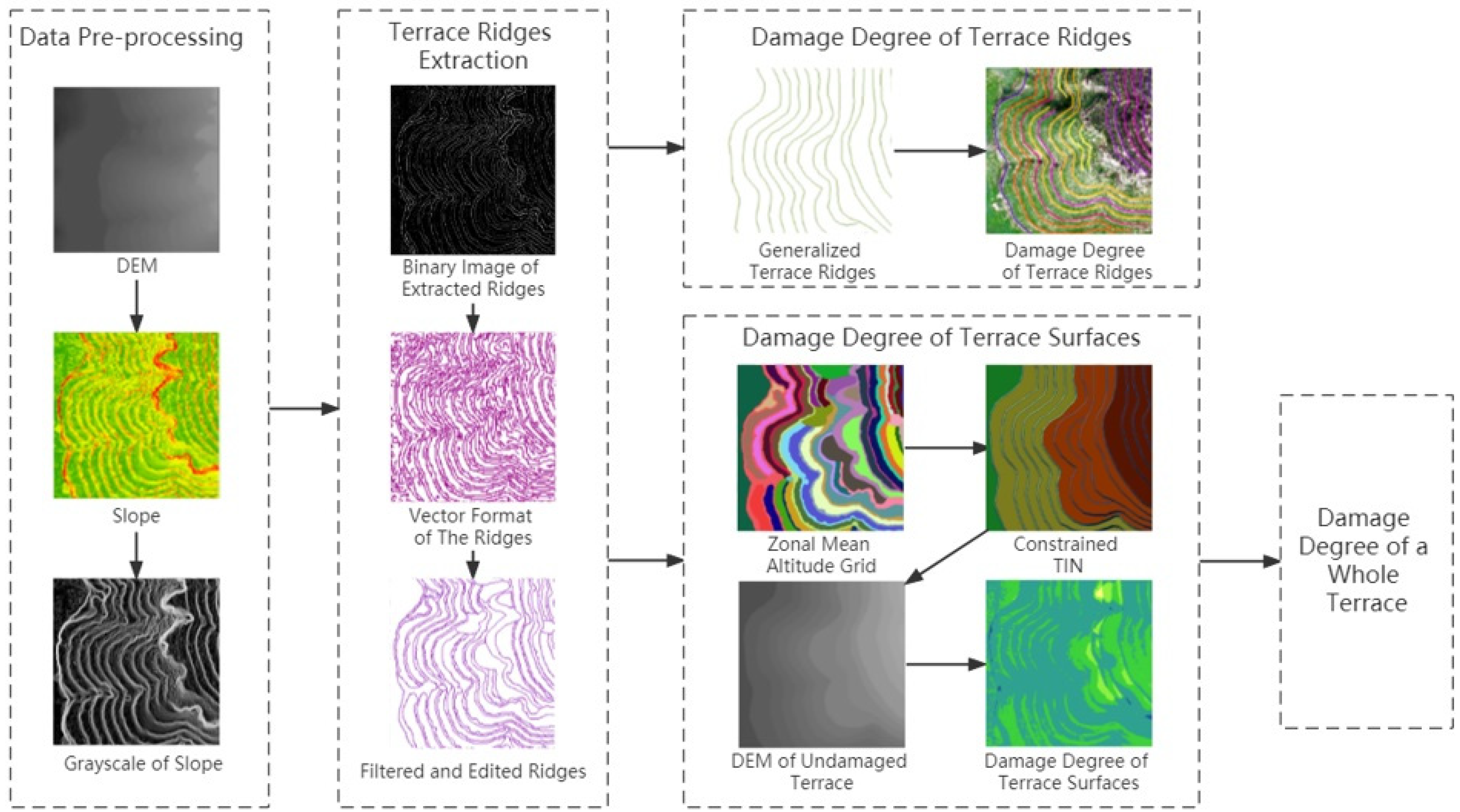

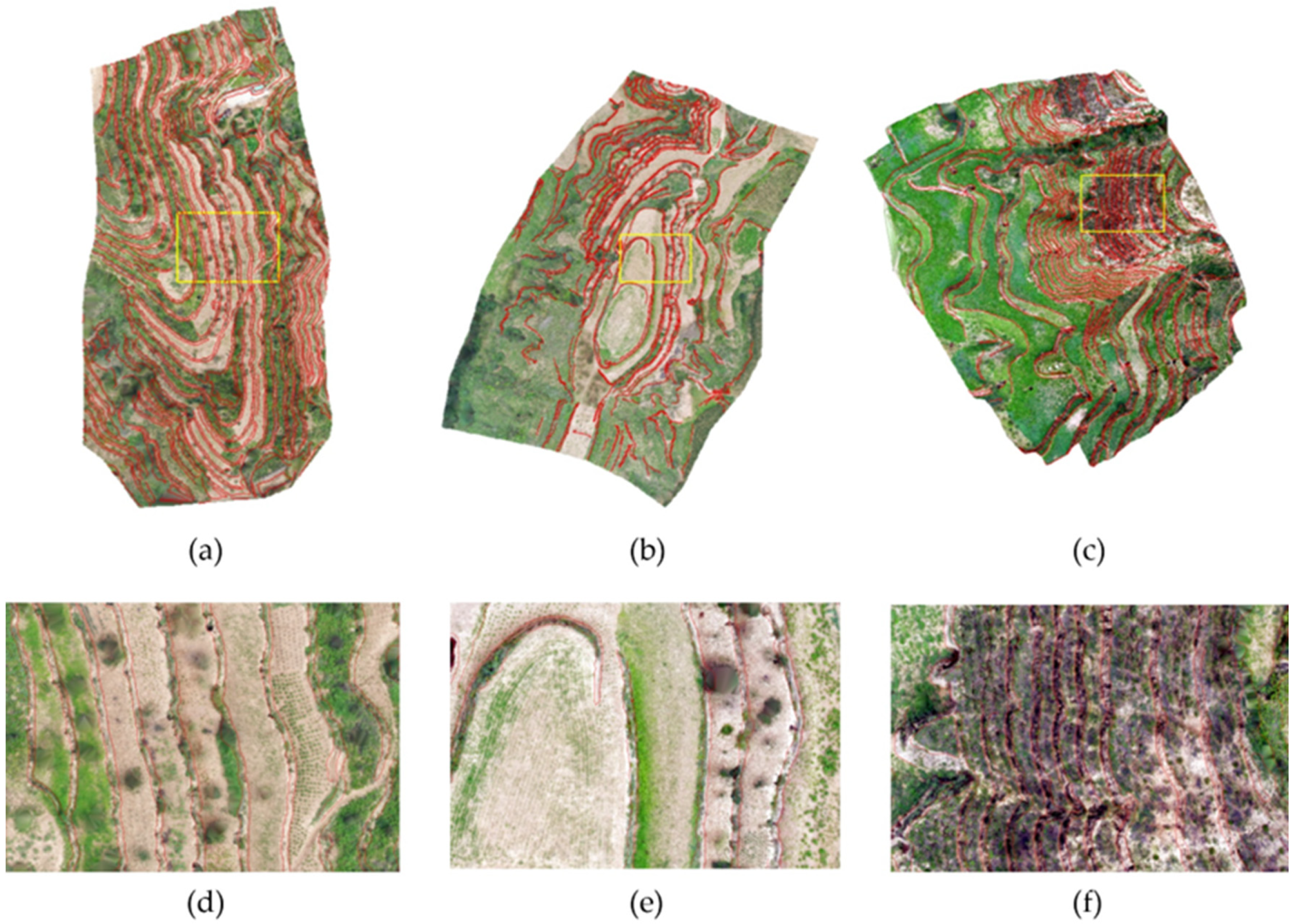
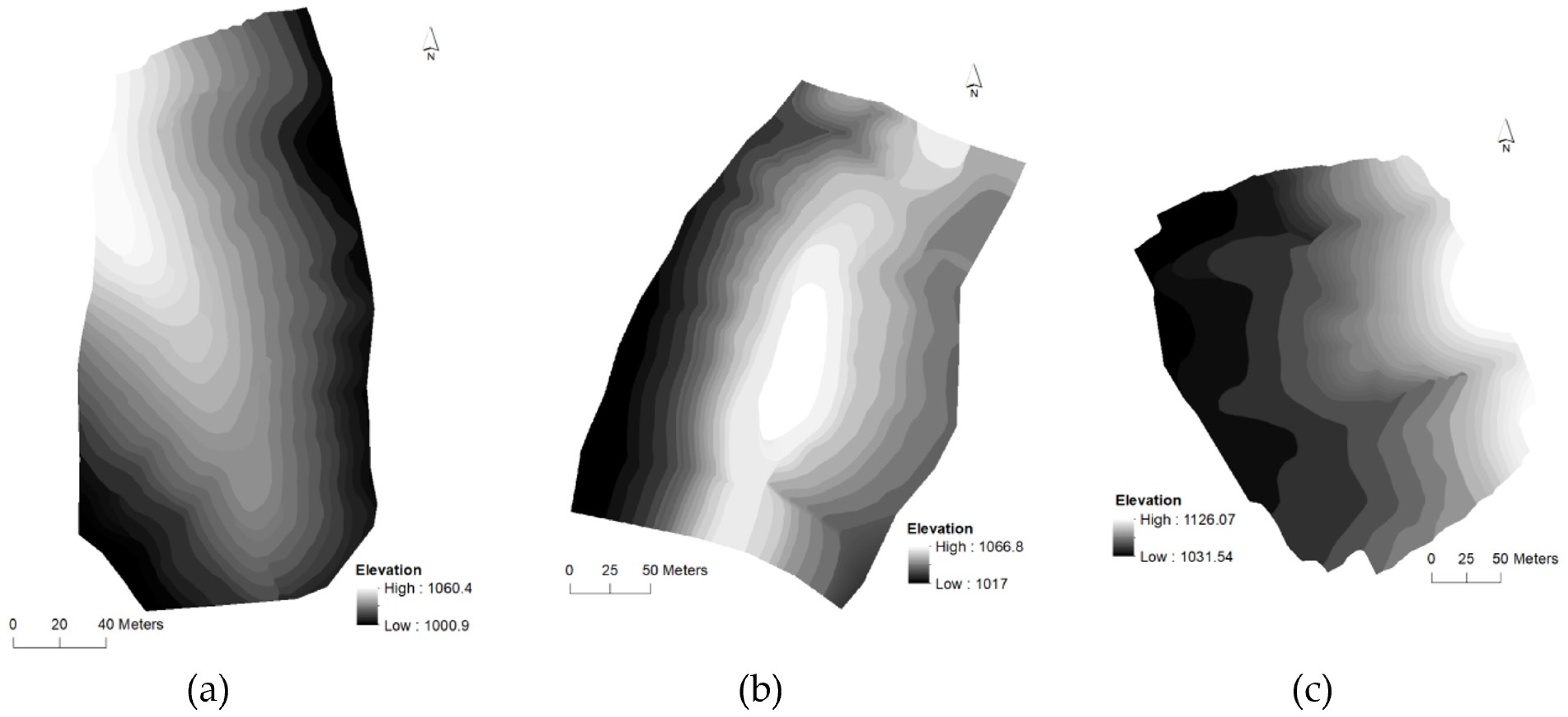
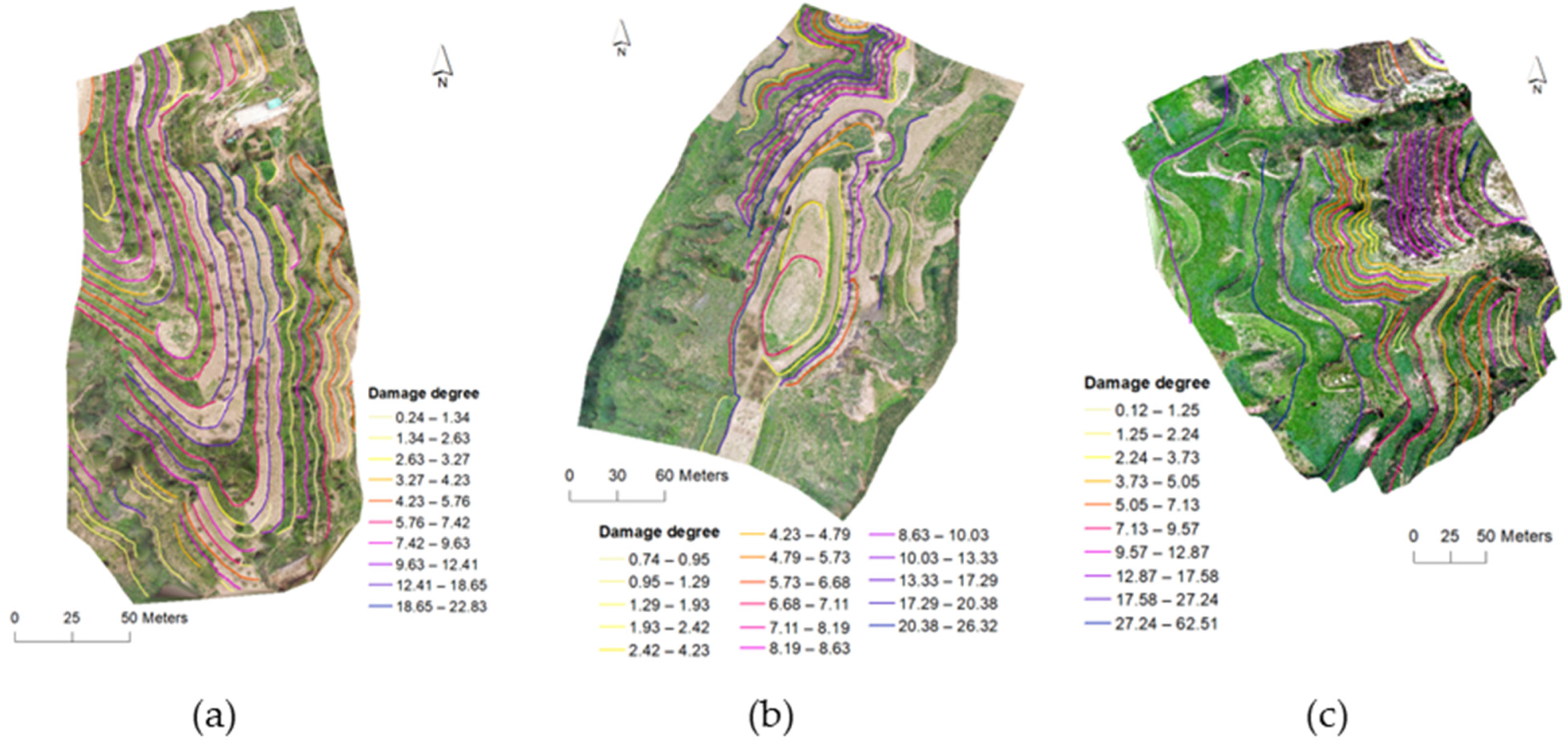
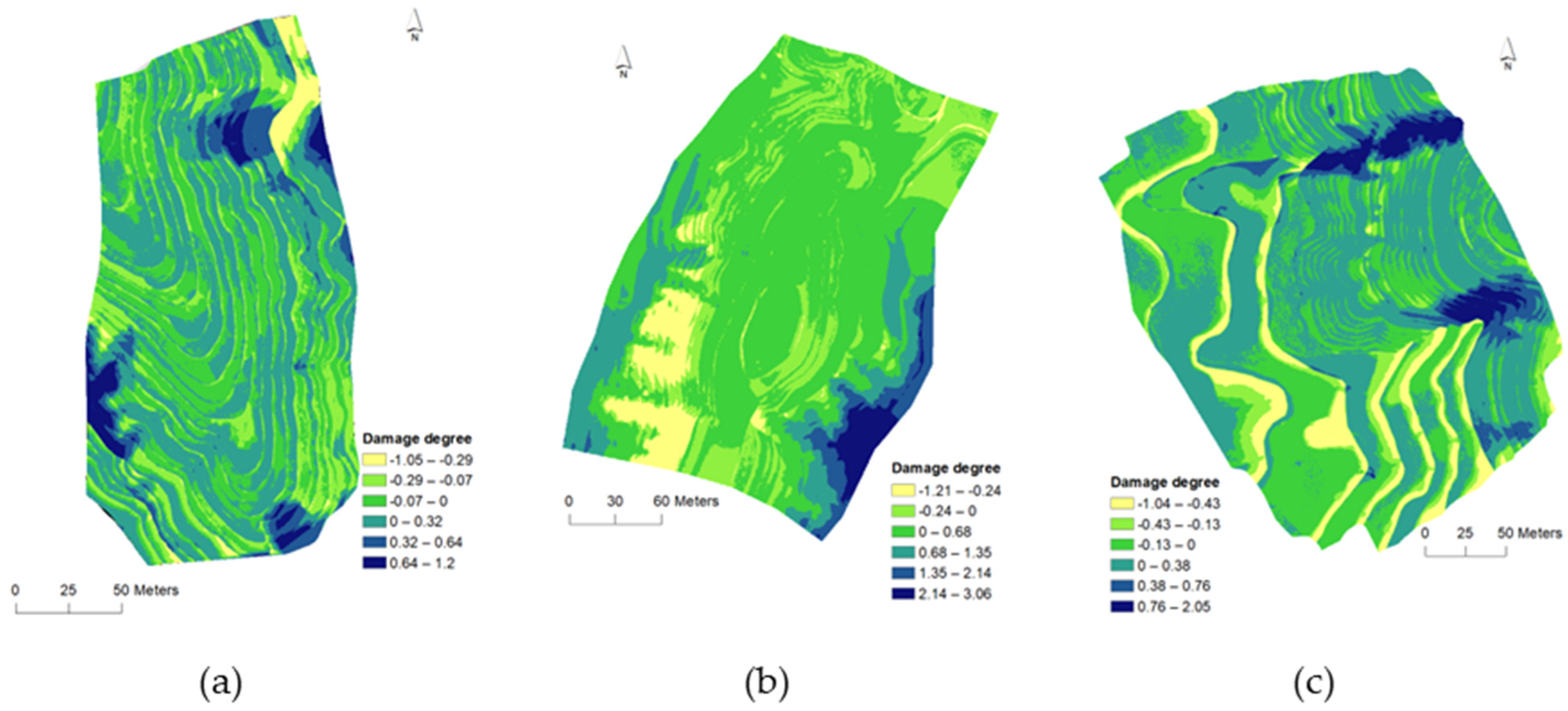

| Study Area | S1 | S2 | S3 |
|---|---|---|---|
| Average Altitude (m) | 1026.13 | 1042.78 | 1068.50 |
| Average Slope (°) | 28.7 | 35.52 | 25.9 |
| Average Wall Height (m) | 3.19 | 3.5 | 3.79 |
| Average Platform Width (m) | 4.86 | 4.99 | 6.36 |
| Area (ha) | 2.82 | 5.44 | 6.45 |
| Study Areas | S1 | S2 | S3 |
|---|---|---|---|
| Completeness | 103.01% | 121.47% | 127.88% |
| Correctness | 93.54% | 50.68% | 71.63% |
| Quality | 96.17% | 55.67% | 85.03% |
| Damage Degree of Terrace Ridges | Percentage in First Study Area (%) | Percentage in Second Study Area (%) | Percentage in Third Study Area (%) |
|---|---|---|---|
| 0–1 | 5.8 | 5.41 | 7.94 |
| 1–3 | 20.29 | 18.92 | 19.05 |
| 3–5 | 14.49 | 8.11 | 12.7 |
| 5–10 | 37.68 | 37.84 | 20.63 |
| 10–20 | 20.29 | 21.62 | 31.75 |
| 20–30 | 1.45 | 8.11 | 4.76 |
| >30 | 0 | 0 | 3.17 |
| Damage Degree of Terrace Surfaces | Percentage in First Study Area (%) | Percentage in Second Study Area (%) | Percentage in Third Study Area (%) |
|---|---|---|---|
| <−1 | 0 | 0.08 | 0 |
| −1~−0.5 | 0.57 | 2.66 | 6.77 |
| −0.5~0 | 47.89 | 23.01 | 40.77 |
| 0~0.5 | 46.2 | 50.64 | 46.77 |
| 0.5~1 | 5.04 | 13.61 | 4.44 |
| 1~1.5 | 0.29 | 4.38 | 1.21 |
| 1.5~2 | 0 | 2.47 | 0.05 |
| 2~2.5 | 0 | 1.92 | 0 |
| >2.5 | 0 | 1.23 | 0 |
Disclaimer/Publisher’s Note: The statements, opinions and data contained in all publications are solely those of the individual author(s) and contributor(s) and not of MDPI and/or the editor(s). MDPI and/or the editor(s) disclaim responsibility for any injury to people or property resulting from any ideas, methods, instructions or products referred to in the content. |
© 2023 by the authors. Licensee MDPI, Basel, Switzerland. This article is an open access article distributed under the terms and conditions of the Creative Commons Attribution (CC BY) license (https://creativecommons.org/licenses/by/4.0/).
Share and Cite
Fang, X.; Gu, Z.; Zhu, Y. Quantification of Agricultural Terrace Degradation in the Loess Plateau Using UAV-Based Digital Elevation Model and Imagery. Sustainability 2023, 15, 10800. https://doi.org/10.3390/su151410800
Fang X, Gu Z, Zhu Y. Quantification of Agricultural Terrace Degradation in the Loess Plateau Using UAV-Based Digital Elevation Model and Imagery. Sustainability. 2023; 15(14):10800. https://doi.org/10.3390/su151410800
Chicago/Turabian StyleFang, Xuan, Zhujun Gu, and Ying Zhu. 2023. "Quantification of Agricultural Terrace Degradation in the Loess Plateau Using UAV-Based Digital Elevation Model and Imagery" Sustainability 15, no. 14: 10800. https://doi.org/10.3390/su151410800
APA StyleFang, X., Gu, Z., & Zhu, Y. (2023). Quantification of Agricultural Terrace Degradation in the Loess Plateau Using UAV-Based Digital Elevation Model and Imagery. Sustainability, 15(14), 10800. https://doi.org/10.3390/su151410800







